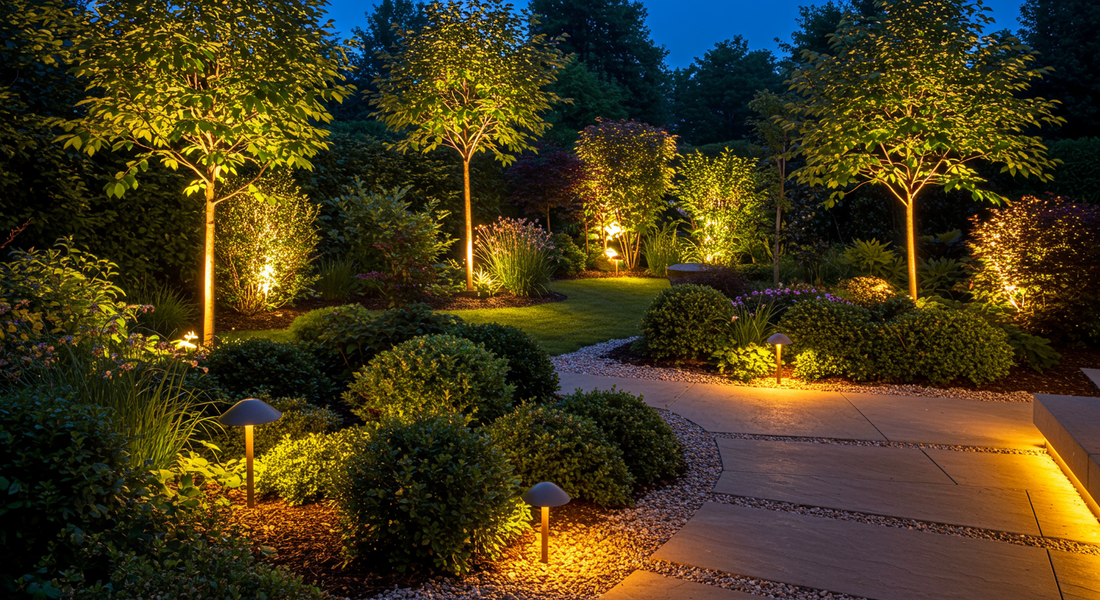
A Beginner's Guide to Landscape Lighting: Design and Installation Tips
Share

As the sun sets, your garden doesn't have to disappear into the darkness. Thoughtful landscape lighting can bring your yard to life after dark, transforming it into a magical and enchanting space. The benefits are threefold: it creates a beautiful ambiance for evening relaxation or entertaining, improves safety by illuminating paths and stairs, and enhances security by deterring potential intruders.
This beginner's guide will walk you through the basics of design and how to install outdoor lighting, helping you create your own stunning nightscape. For most homeowners, the choice comes down to two main systems: traditional low voltage landscape lighting and modern solar pathway lights.
The Three Layers of Landscape Lighting
A professional-looking design incorporates three distinct layers of light to create depth and visual interest.
-
Ambient Lighting: This is the overall, gentle illumination of your garden. It's not meant to be bright, but rather to provide a soft, foundational glow. This can be achieved with techniques like downlighting from a high tree branch.
-
Task Lighting: This is functional lighting focused on safety and navigation. Task lights are used to illuminate walkways, stairs, and entryways, ensuring you and your guests can move around safely after dark.
-
Accent Lighting: This is where the artistry comes in. Accent lights are used to highlight specific features in your yard, such as a beautiful tree, a textured stone wall, or a piece of garden art.
Popular Lighting Techniques
These are some of the most popular landscape lighting ideas and techniques to add drama and beauty to your yard.
-
Uplighting: Placing a spotlight at the base of a tree or a dramatic shrub and angling it upwards creates a striking effect, highlighting its texture and form.
-
Downlighting (or "Moonlighting"): Mounting a light high up in a mature tree and angling it downwards mimics the gentle glow of moonlight, casting beautiful, dappled shadows on the ground below.
-
Path Lighting: Using a series of low-profile lights along a walkway to guide the way. The goal is to illuminate the path itself, not to create bright pools of light.
-
Silhouetting: Placing a light source behind a feature and aiming it towards a wall or fence. This creates a dark outline of the object for a dramatic, artistic effect.
Low-Voltage System Installation Basics
A low-voltage system is the most common and reliable type of landscape lighting. It's safe and relatively easy for a DIYer to install.
-
The Components: A low-voltage system consists of three main parts:
-
The Transformer: This plugs into a standard GFCI outdoor outlet and "steps down" your home's 120-volt electricity to a safe 12 volts.
-
The Cable: A heavy-gauge, outdoor-rated cable runs from the transformer to your light fixtures.
-
The Fixtures: These are the lights themselves.
-
-
Installation Overview:
-
Mount the transformer on an exterior wall near your outlet.
-
Lay out your light fixtures in their desired locations.
-
Run the low-voltage cable from the transformer to each fixture.
-
Attach each fixture to the cable using the simple, tool-free connectors that typically come with the lights.
-
Bury the cable a few inches under the soil or mulch.
-
Solar Lighting: The Easiest Option
For ultimate simplicity, solar pathway lights and accent lights are a fantastic choice.
-
Pros and Cons: The pros are obvious: they are incredibly easy to install (just stake them in the ground), require no wiring, and have zero energy cost. The cons are that their brightness and runtime are entirely dependent on the amount of sunlight they receive, and the built-in batteries will eventually need to be replaced.
-
Best Uses for Solar: Solar lights are perfect for areas that are difficult to run a wire to or for adding a touch of ambient light along a path or in a flower bed. While they may not be as bright or reliable as a low-voltage system, their convenience is unmatched for many applications.
Conclusion: Designing a Magical Nightscape
A well-designed landscape lighting scheme can completely transform the look and feel of your home's exterior. By layering ambient, task, and accent lighting, and by choosing the right system for your needs, you can create a magical nightscape that is safe, secure, and beautiful to behold for years to come.
